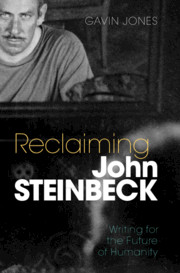Book contents
- Reclaiming John Steinbeck
- Reclaiming John Steinbeck
- Copyright page
- Dedication
- Contents
- Figures
- Acknowledgments
- Introduction Loving and Hating Steinbeck
- Chapter 1 Short Stories in School and Lab: “Tularecito” and “The Snake”
- Chapter 2 Drought, Climate, and Race in the West: To a God Unknown
- Chapter 3 Race and Revision: “The Vigilante” and “Johnny Bear”
- Chapter 4 Becoming Animal: Theories of Mind in The Red Pony
- Chapter 5 What Is It Like to Be a Plant? “The Chrysanthemums” and “The White Quail”
- Chapter 6 On Not Being a Modernist: Disability and Performance in Of Mice and Men
- Chapter 7 Emergence and Failure: The Middleness of The Grapes of Wrath
- Chapter 8 Borderlands: Extinction and the New World Outlook in Sea of Cortez
- Chapter 9 Mexican Revolutions: The Forgotten Village, The Pearl, and the Global South
- Epilogue The Aftertaste of Cannery Row
- Notes
- Index
Chapter 3 - Race and Revision: “The Vigilante” and “Johnny Bear”
Published online by Cambridge University Press: 02 July 2021
- Reclaiming John Steinbeck
- Reclaiming John Steinbeck
- Copyright page
- Dedication
- Contents
- Figures
- Acknowledgments
- Introduction Loving and Hating Steinbeck
- Chapter 1 Short Stories in School and Lab: “Tularecito” and “The Snake”
- Chapter 2 Drought, Climate, and Race in the West: To a God Unknown
- Chapter 3 Race and Revision: “The Vigilante” and “Johnny Bear”
- Chapter 4 Becoming Animal: Theories of Mind in The Red Pony
- Chapter 5 What Is It Like to Be a Plant? “The Chrysanthemums” and “The White Quail”
- Chapter 6 On Not Being a Modernist: Disability and Performance in Of Mice and Men
- Chapter 7 Emergence and Failure: The Middleness of The Grapes of Wrath
- Chapter 8 Borderlands: Extinction and the New World Outlook in Sea of Cortez
- Chapter 9 Mexican Revolutions: The Forgotten Village, The Pearl, and the Global South
- Epilogue The Aftertaste of Cannery Row
- Notes
- Index
Summary
On November 27, 1933, in San Jose, California, two white men were lynched by an angry mob for allegedly kidnapping and murdering a local celebrity. This chapter traces Steinbeck’s interest in the event and the difficult process of writing about it that would culminate in his short story “The Vigilante” in The Long Valley--a story largely faithful to the historical events but that changes the racial identity of the lynching victims from white to black, and tells the story from a lyncher’s point of view. Drawing on manuscript evidence, on Steinbeck’s developing theory of group psychology (what he called the “phalanx”), and on the history of lynching--and lynching photography--in the United States, the chapter argues that the power of Steinbeck’s short story emerges from its disturbing participation, like a souvenir, in a moment of racist violence. Steinbeck’s problematic play with the short story form is reversed in his story “Johnny Bear,” which employs unreliable narration to undermine the authority of white power by exposing the interracial sexual affairs that lie at its heart.
- Type
- Chapter
- Information
- Reclaiming John SteinbeckWriting for the Future of Humanity, pp. 54 - 72Publisher: Cambridge University PressPrint publication year: 2021



